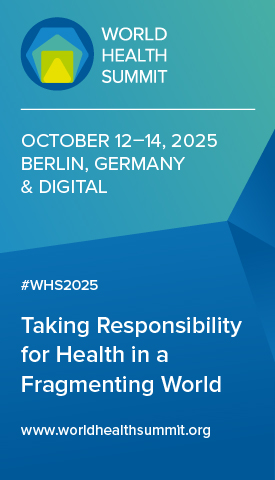Holistic heart health care
Cardiovascular disease is the leading cause of death worldwide.1 To address this global health challenge, secured and continuous scientific innovation and multidisciplinary collaboration as well as better prevention and lifestyle changes are needed
Cardiovascular disease (CVD) is a major global health challenge. CVD includes widespread conditions of the heart and blood vessels such as heart attack and stroke, causing 17.9 million deaths annually.2 In Europe, more than 10,000 lives are lost every day,3 with 60 million people affected in 2020.4 The economic impact is significant, costing Europe €282 billion annually.5
The burden of CVD varies considerably across different regions – 80% of global CVD deaths occur in low- and middle-income countries, where access to preventive health care, timely diagnosis and effective treatment is often limited.6
In addition to the regional differences in CVD care, there are also gender inequalities. Although women generally have lower CVD rates, studies show that they have worse outcomes after an acute cardiovascular event.7 Moreover, women are often underrepresented in cardiovascular clinical trials.8
Regarding research, recent medical progress in CVD care has lagged other areas of medicine.9 It is concerning that insufficient public investment and lack of commitment could reverse the progress that has been achieved in reducing mortality from CVD.10 We at Daiichi Sankyo Europe believe that to achieve progress in CV care and treatment optimisation, we need a holistic approach: adopting a new mindset in healthcare policies, enhancing prevention strategies, encouraging lifestyle changes, promoting collaboration and fostering medical innovation. This approach should emphasise cross-disciplinary collaboration, involving clinicians, other health professionals, patient organisations, payor bodies and industry associations, because combating CVD effectively demands a multifaceted, multistakeholder strategy.
Furthermore, no country should be without a national heart health plan.11 The new World Health Organization signature initiative, started in 2022, sets the direction.12 It promotes better heart health through a healthier diet and enhancing hypertension control, a major risk factor. In Europe, the European Alliance for Cardiovascular Health has been formed to advocate an EU plan for Cardiovascular Health.13
At Daiichi Sankyo Europe, we are supporting the work of the European Nutrition for Health Alliance and their Optimal Nutritional Care for All campaign. We believe that health care can only be improved by bringing together likeminded, caring groups and individuals, who share our passion and commitment to improving health outcomes for people facing CVD. We collaborate with patient organisations and develop public disease awareness campaign frameworks across Europe, focusing on our areas of expertise: atrial fibrillation and LDL-cholesterol. We aim to increase health literacy and promote prevention in a holistic, human-centric way. Our new website, www.wecareforeveryheartbeat.com, is the central hub for these efforts.
Since 2002, Daiichi Sankyo has been driving medical progress in the field of CVD through the successful development of innovative therapies and has helped to treat millions of patients across Europe. We have invested in multi-centred, double-blinded clinical trials, as well as studies in routine clinical practice, to bring scientific information to the medical community, helping to better understand CVD and improve patient care.
For example, in early 2024, we convened a first-of-its-kind think-tank roundtable dedicated to formulating a holistic approach to heart health and care. It brought together 11 renowned representatives from nutrition science, psychology, sports science, nurses, patient representatives, journalists and cardiologists across Europe to discuss how to effectively implement holistic CVD management. The expert session combined the different perspectives into a set of clear calls to action.
Our vision for the future is one where cardiovascular health is not just a matter of individual concern but a collective priority that shapes policies, health systems and societal norms. By fostering collaboration and embracing a holistic mindset, we can help drive change in the prevention, diagnosis and treatment of CVD, ultimately saving lives.
References
¹ World Health Organization, Cardiovascular diseases (CVDs). Available at: https://www.who.int/news-room/fact-sheets/detail/cardiovascular-diseases-(cvds). Last accessed Aug. 2024
2 World Health Organization, Cardiovascular diseases (CVDs). Available at: https://www.who.int/news-room/fact-sheets/detail/cardiovascular-diseases-(cvds). Last accessed Aug. 2024
3 The Task Force for the management of dyslipidaemias of the European Society of Cardiology (ESC) and European Atherosclerosis Society (EAS). ESC/EAS guidelines for the management of dyslipidaemias. Eur Heart J. 2020. 41(1): 111–188. Available at: https://academic.oup.com/eurheartj/article/41/1/111/5556353?. Last accessed Aug. 2024
4 European Society of Cardiology. Fighting cardiovascular disease – a blueprint for EU action. June 2020. Available at: https://www.escardio.org/static-file/Escardio/Advocacy/Documents/2020%20ESC-EHN-blueprint_digital%20edition.pdf. Last accessed Aug. 2024.
5 Ramon Luengo-Fernandez, Marjan Walli-Attaei, Alastair Gray, Aleksandra Torbica, Aldo P Maggioni, Radu Huculeci, Firoozeh Bairami, Victor Aboyans, Adam D Timmis, Panos Vardas, Jose Leal, Economic burden of cardiovascular diseases in the European Union: a population-based cost study, European Heart Journal, Volume 44, Issue 45, 1 December 2023, Pages 4752–4767. Available at https://doi.org/10.1093/eurheartj/ehad583. Last accessed Aug. 2024
6 Ana Olga Mocumbi, Cardiovascular Healthcare in Low- and Middle Income Countries, Feb. 2024. Available at: Circulation. 2024;149:557–559. Available at https://doi.org/10.1161/CIRCULATIONAHA.123.065717. Last accessed Aug. 2024
7 Suman S, Pravalika J, Manjula P, Farooq U. Gender and CVD- Does It Really Matters? Curr Probl Cardiol. 2023 May;48(5):101604. Available at: https://doi.org/10.1016/j.cpcardiol.2023.101604. Last accessed Aug. 2024
8 Jin X, Chandramouli C, Allocco B, Gong E, Lam CSP, Yan LL. Women’s Participation in Cardiovascular Clinical Trials From 2010 to 2017. Circulation. 2020 Feb 18;141(7):540-548. Available at https://doi.org/10.1161/CIRCULATIONAHA.119.043594. Last accessed Aug. 2024
9 Dunlay, Shannon M., and Amy Grodzinsky. “2021 AHA/ACC/HFSA Focused Update of the 2017 AHA/ACC/HFSA Focused Update of the 2017 AHA/ACC/HFSA Heart Failure Guidelines.” Circulation, vol. 144, no. 5, 2021, pp. e295–e314. American Heart Association Journals, https://doi.org/10.1161/CIR.0000000000000652. Last accessed Aug. 2024
10European Society of Cardiology. “Fighting Cardiovascular Disease: A Blueprint for EU Action.” European Society of Cardiology, www.escardio.org/The-ESC/Advocacy/fighting-cardiovascular-disease-a-blueprint-for-eu-action. Last accessed Aug. 2024.
11European Society of Cardiology. “Fighting Cardiovascular Disease: A Blueprint for EU Action.” European Society of Cardiology, www.escardio.org/The-ESC/Advocacy/fighting-cardiovascular-disease-a-blueprint-for-eu-action. Last accessed Aug. 2024.
12World Health Organization. “WHO Launches Signature Initiative to Reduce Cardiovascular Disease through Salt Reduction and Hypertension Control.” World Health Organization, 9 Dec. 2022, https://www.who.int/europe/news-room/events/item/2022/12/09/default-calendar/who-launches-signature-initiative-to-reduce-cardiovascular-disease-through-salt-reduction. Last assessed Aug. 2024.
13European Alliance for Cardiovascular Health. EACH Cardiovascular Health Plan for Europe. 13 May 2022, https://www.cardiovascular-alliance.eu/wp-content/uploads/2022/05/EACH-Plan-Final_130522.pdf. Last assessed Aug. 2024












